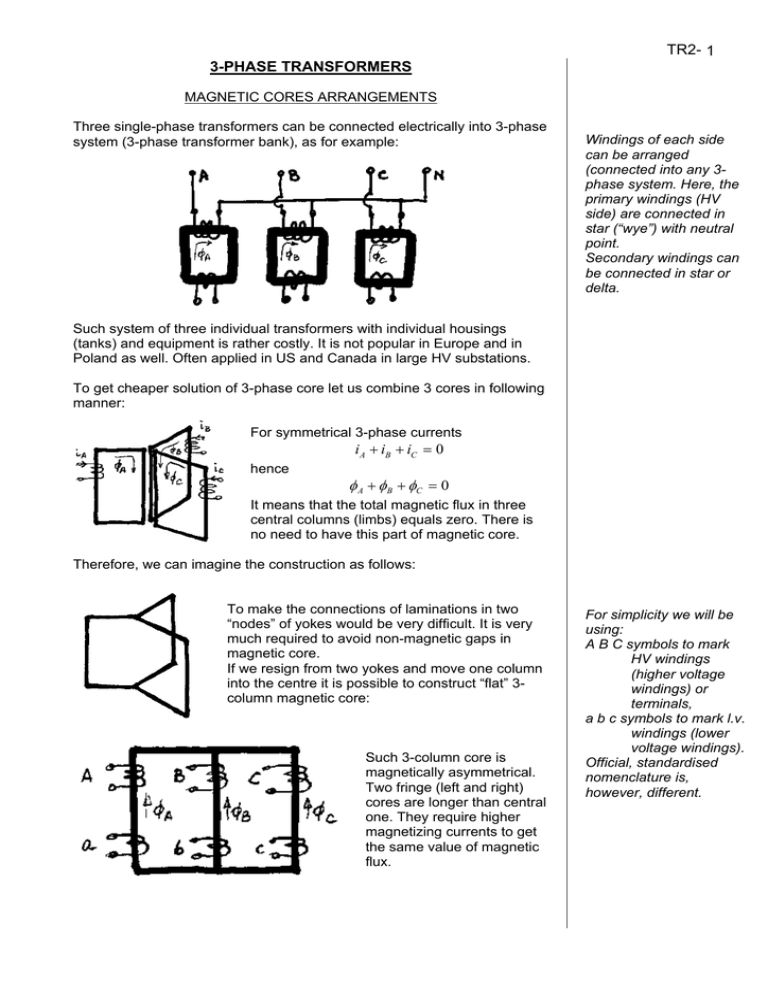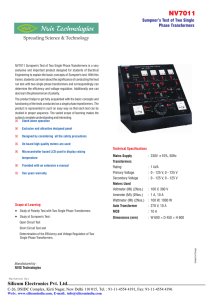3-phase transformers
advertisement

TR2- 1 3-PHASE TRANSFORMERS MAGNETIC CORES ARRANGEMENTS Three single-phase transformers can be connected electrically into 3-phase system (3-phase transformer bank), as for example: Windings of each side can be arranged (connected into any 3phase system. Here, the primary windings (HV side) are connected in star (“wye”) with neutral point. Secondary windings can be connected in star or delta. Such system of three individual transformers with individual housings (tanks) and equipment is rather costly. It is not popular in Europe and in Poland as well. Often applied in US and Canada in large HV substations. To get cheaper solution of 3-phase core let us combine 3 cores in following manner: For symmetrical 3-phase currents iA + iB + iC = 0 hence φ A + φ B + φC = 0 It means that the total magnetic flux in three central columns (limbs) equals zero. There is no need to have this part of magnetic core. Therefore, we can imagine the construction as follows: To make the connections of laminations in two “nodes” of yokes would be very difficult. It is very much required to avoid non-magnetic gaps in magnetic core. If we resign from two yokes and move one column into the centre it is possible to construct “flat” 3column magnetic core: Such 3-column core is magnetically asymmetrical. Two fringe (left and right) cores are longer than central one. They require higher magnetizing currents to get the same value of magnetic flux. For simplicity we will be using: A B C symbols to mark HV windings (higher voltage windings) or terminals, a b c symbols to mark l.v. windings (lower voltage windings). Official, standardised nomenclature is, however, different. ELECTRICAL CONNECTIONS OF WINDINGS TR2- 2 Nomenclature: Symbols of transformer windings connections: Y, D, (Z) - higher voltage side connections in star, delta, (zig-zag) y, d, z lower voltage side connections in star, delta, zig-zag Phase displacement: - the angle of advance in passing from l.v. phasor to HV phasor in counter-clockwise direction, described in hours (1 hour ⇔ 30o); (HV phasor at 12 o'clock and the l.v. phasor at a given hour: ...for example 0, 5, 11) Winding terminals lettering (symbols): 1A; 1B, 1 C - Higher voltage windings (1A1 - the beginning and 1A2 - the end of the winding of phase A) 2A, 2B, 2C - lower voltage windings (2A1-2A2 - accordingly) Examples of connections: HV side connected in star, Y; l.v. side connected in star, y; l.v. phasor U2A delays by 180o ⇒ 6 hours Yy6 In case the neutral points are connected to output terminals: YNy6 or Yyn6 Relation between voltage and turns ratios U 3 × 4.44 N HV fΦ N HV ϑYy = HV = = = ϑz U lv N lv 3 × 4.44 N lv fΦ Yd5 There is another way of delta connection. Different ends of delta windings can be led to output terminals. Another phase displacements possible. Relation between voltage and turns ratios ϑYd = 3 × 4.44 N HV fΦ U HV N = = 3 HV = 3ϑz 4.44 N lv fΦ U lv N lv ZIG-ZAG CONNECTED WINDING TR2- 3 Each phase winding is divided into halves. The circuit of one phase is a connection of one halfwinding from one column and reversed half-winding of next column, and so on in the same order. Connection of neutral point means that zig-zag is a “star-type” connection (interconnected star). Phase voltage of zig-zag connected winding is smaller than it would be for star connection of the same halves. From the triangle Uy 3 U fz = 2 × U y ≈ 0.86U y cos 30o = 2 2 STANDARD CONNECTIONS FOR 3-PHASE TRANSFORMERS (Groups of connections) In practice the zig-zag connections are applied only at l.v. sides of distribution transformers (as in numerical example at the end of this chapter). Zig-zag connection requires 14% more copper wires to get the same voltage as in star connected winding. VOLTAGE CONTROL IN TRANSFORMERS. TAP CHANGING In transformers with high value of short-circuit voltage the variation of output voltage can be to big for receiver(s). The only possible method of output voltage control is to change the turn ratio of the transformer. For this purpose the special terminals (taps) from the appropriate parts of HV winding are applied: Tap changing↔changing the turn ratio of the transformer. Tap-changing circuit is usually connected at HV side. Tap position 0 corresponds to rated number of turns of the winding (number of turns that corresponds to rated voltage of this winding). Taps of different steps are possible, for example: -5%; +5%; +10% of rated number of turns. There are two basic methods of realisation of circuit reconnection: NTC – No-load Tap Changer (off-circuit tap changing) The reconnection of the circuit, i.e. the switching of the sliding contact from one tap to another cannot be done when the transformer is in operation due to the danger of sparks or arc at contacts being disconnected. Short-circuiting of taps is also not allowed. The procedure of tap changing is as follows: 1. Disconnection of transformer from the supply, 2. Changing of tap by means of selector, 3. Switching on the transformer. OTC – On-load Tap Changer Transformer circuit is connected through the tap at left side selector contact. To change the tap the procedure must be followed: 1. New tap (adjacent) is chosen by means of left-side selector contact; 2. Sliding contact of diverter switch is moved (quickly) clockwise and for short period of time the inter-tap part of the winding is short-circuited by 2R. The short-circuit currents are of limited value. 3. After a fraction of second the tapchanging operation is completed with new position of selector switch and without breaking the circuit. TR2- 4 NUMERICAL EXAMPLE Consider the 3-phase transformer of rating (typical catalogue data are given): Group of connection Yz11 Rated power SN=100 kVA Rated voltage 15.75/0.4 kV Voltage control (at HV side) +2.5% -3×2.5% (15.75+2.5% -3×2.5%/0.4 kV) Short-circuit voltage uk%=4.5% Rated iron loss ∆PFeN=255 W Rated copper loss ∆PCuN=1900 W It operates as step-down transformer, supplied from 15 kV line of distribution system and loaded with P2=80 kW and power factor 0.8 lagging. Calculate the output voltage at 0 position of tap-changer and the voltage at its position of –2.5%. P2 = 80 kW ; cosϕ 2 = 0.8 S U 2 = U 2o 1 − 2 SN U1N U1 ⇒ S2 = 80 P2 = = 100 kVA cos ϕ 2 0.8 2 ∆U rN ∆U rN = URkr cos ϕ 2 + U Xkr sinϕ 2 ∆PCuN 1.9 U Rkr = SN = 100 = 0.019 p.u. 2 U Xkr = U kr2 − U Rkr = 0.045 2 − 0.019 2 = 0.0408 ∆U rN = 0.019 × 0.8 + 0.0408 × 0.6 = 0.0397 for 0 - position of tap - changer 15 = 380.95 V 15.75 100 15.75 2 U 2 = 380.95 1 − × 0.0397 = 364.28 V 100 15 U 2o = 400 × phase voltage = 364.28 / 3 = 210.3 V for - 2.5% - position of tap - changer 15 = 390.72 V U 2o = 400 × 0.975 × 15.75 100 15.75 2 U 2 = 390.721 − × 0.0397 = 373.62 V 100 15 and phase voltage = 373.62/ 3 = 215.7 V TR2- 5 AUTOTRANSFORMERS TR2- 6 Part OA of the winding is common to primary and secondary sides. Primary and secondary circuits are electrically connected. ZAB – short circuit impedance – can be small ⇒ short-circuit current can be high. I1 = I 2 + I 3 or, assuming that the currents are in phase I1 = I 2 + I3 From U1I1=U2I2 we have ϑ= U1 N1 I2 = = U 2 N2 I1 and finally 1− ϑ − I2 = I2 ϑ ϑ from where it can be seen that for ϑ →1 I3→0. For ϑ=1/2 (or 2) saving of the copper is about 50% comparing to typical 2winding transformer. Such autotransformer’s price is about 60-70% of 2winding transformer of the same nominal power. Applications - in laboratories (small variable voltage sources), - in electrical power system (connection of two lines of similar voltage, for example 220 and 110 kV – coupling transformers. I3 = I1 − I2 = I2 THREE-WINDING TRANSFORMERS 3-winding power transformers are often applied in power system substations to provide the supply of local receivers. Transformer with tertiary winding, additional to primary and secondary windings. Location of low, medium and high voltage windings in transformer’s window Z 1 = 1/ 2(Z 12 + Z 13 − Z 23 ) ' Z 2 = 1/ 2(Z 12 + Z 23 − Z 13 ) Z 13 = Z 1 + Z 3 ' ' ' ' Z 12 = Z 1 + Z 2 ' Z 23 = Z 2 + Z 3 ' ' ' ' Z 3 = 1/ 2(Z 13 + Z 23 − Z 12 ) PARALLEL OPERATION OF TRANSFORMERS Parallel connection of two or more transformers can be reasonable in some cases when higher reliability of supply is required. TR2- 7 In case of one transformer failure the supply of receivers is continued due to the second transformer operation (some reduction of the load can be eventually required). Probability of simultaneous failures of two transformers is much smaller. Parallel operation of two transformers can be assessed as technically correct if the following basic requirements are satisfied: 1. In common secondary circuit of two transformers the current flowing at no-load state should be zero (or practically negligible). Example of two 1-phase transformers. The current circulating in the closed secondary circuit is zero when: (ΣE=0) EI=EII In case of 3-phase transformers it corresponds to the following two conditions of 1st requirement fulfilment: 1a) – Voltage ratios of transformers must be equal (⇒EI=EII); 1b) – Groups of connection must be the same (the same phase displacement), for example: Yd5, Dy5, Yz5; (finally, together with condition 1a ⇒EI=EII). 2. Total load of the system is to be shared proportionally to nominal powers of transformers. We need: SI S = NI SII SNII From the diagram of two simplified equivalent circuits we have: Z kI I I = Z kII I II and II Z = kII I II Z kI Z kII U N × U N I NII U N II I = NII Z kI U N U N I II × U N I NI I NI SI S Z = NI × krII S II S NII Z krI or SI S U = NI × krII S II S NII U krI 2a) – To have the loads of transformers shared proportionally to their nominal powers their p.u. short-circuit voltages have to be equal. Connection of transformers to the busbars must be made with the same polarity. TR2- 8 3. Currents of particular transformers summing up in the busbars should be in phase. Total power from paralleled transformers should be an algebraic sum. Fulfilment of this requirement means that I=II+III (not I=II+III) It means also that S=SI+SII Total apparent power of two transformers connected in parallel is an algebraic sum of their powers (not a vector sum). Currents II and III are in phase when α = ΦI - ΦII = 0 It appears when voltage drop triangles are the same, i.e. when short-circuit angles Φ kI = Φ kII ⇒ RkI R = kII X kI X kII Such equality of parameters’ ratios occurs for transformers not too much different in size, not too much different in the value of nominal power. In practice: 3a) – The ratio of nominal powers of transformers connected to parallel operation should not exceed the value of 3. SNI ≤3 SNII



